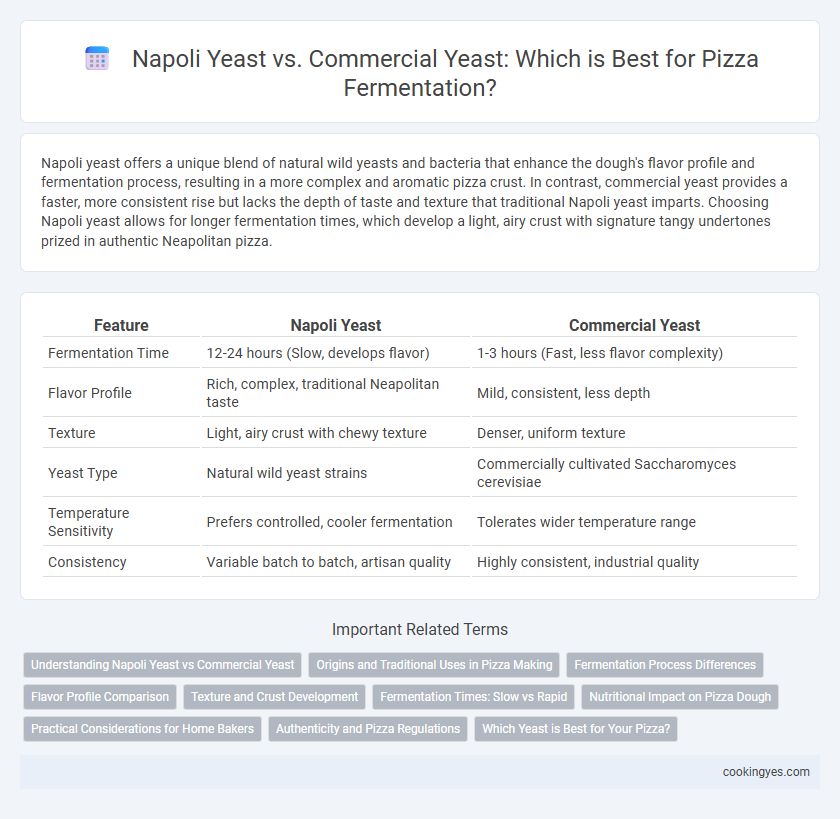Napoli yeast offers a unique blend of natural wild yeasts and bacteria that enhance the dough's flavor profile and fermentation process, resulting in a more complex and aromatic pizza crust. In contrast, commercial yeast provides a faster, more consistent rise but lacks the depth of taste and texture that traditional Napoli yeast imparts. Choosing Napoli yeast allows for longer fermentation times, which develop a light, airy crust with signature tangy undertones prized in authentic Neapolitan pizza.
Table of Comparison
| Feature | Napoli Yeast | Commercial Yeast |
|---|---|---|
| Fermentation Time | 12-24 hours (Slow, develops flavor) | 1-3 hours (Fast, less flavor complexity) |
| Flavor Profile | Rich, complex, traditional Neapolitan taste | Mild, consistent, less depth |
| Texture | Light, airy crust with chewy texture | Denser, uniform texture |
| Yeast Type | Natural wild yeast strains | Commercially cultivated Saccharomyces cerevisiae |
| Temperature Sensitivity | Prefers controlled, cooler fermentation | Tolerates wider temperature range |
| Consistency | Variable batch to batch, artisan quality | Highly consistent, industrial quality |
Understanding Napoli Yeast vs Commercial Yeast
Napoli yeast, a traditional natural yeast derived from local wild strains, enhances pizza dough with complex flavors and a distinct texture due to its slower, longer fermentation process compared to commercial yeast. Commercial yeast, typically Saccharomyces cerevisiae, offers rapid and consistent fermentation ideal for fast production but often yields less nuanced dough profiles. Understanding the fermentation kinetics and microbial diversity differentiates Napoli yeast's artisanal characteristics from the efficiency-driven traits of commercial yeast, impacting crust flavor, aroma, and digestibility.
Origins and Traditional Uses in Pizza Making
Napoli yeast, traditionally derived from natural sourdough cultures native to the Naples region, offers a slow fermentation process that enhances flavor complexity and dough texture in authentic Neapolitan pizza making. Commercial yeast, typically Saccharomyces cerevisiae, originated in industrial baking and provides faster, more predictable fermentation suited for mass production and consistent results. The use of Napoli yeast preserves artisanal methods and regional culinary heritage, while commercial yeast supports efficiency and scalability in modern pizza preparation.
Fermentation Process Differences
Napoli yeast, derived from traditional wild strains, ferments dough more slowly and produces a richer flavor profile with natural sweetness and complex aromas, enhancing the pizza's texture and digestibility. Commercial yeast, typically Saccharomyces cerevisiae, acts faster but generates fewer aromatic compounds, leading to a more neutral taste and uniform rise. The slower fermentation of Napoli yeast allows better gluten development and moisture retention, critical for authentic Neapolitan pizza crust.
Flavor Profile Comparison
Napoli yeast enhances pizza dough fermentation by producing complex, fruity, and slightly tangy flavor notes due to its natural wild yeast strains, resulting in a more aromatic and traditional taste profile. Commercial yeast, typically Saccharomyces cerevisiae, offers a faster and more consistent rise but yields a milder, less nuanced flavor that can lack the characteristic depth found in Napoli yeast-fermented dough. The choice between Napoli and commercial yeast significantly impacts the final pizza crust's texture, aroma, and overall flavor authenticity.
Texture and Crust Development
Napoli yeast promotes a slower fermentation process, resulting in a light, airy texture and a well-developed, slightly chewy crust with rich flavor complexity. Commercial yeast accelerates fermentation, producing a softer crumb and a thinner crust with less nuanced taste and texture. Choosing Napoli yeast enhances crust development by allowing gluten to mature fully, creating superior elasticity and a traditional Neapolitan pizza mouthfeel.
Fermentation Times: Slow vs Rapid
Napoli yeast, known for its natural wild strains, promotes a slow and steady fermentation, typically lasting 24 to 48 hours, which enhances flavor complexity and dough texture. Commercial yeast, often Saccharomyces cerevisiae, accelerates fermentation, reducing dough proofing to 1-3 hours but may result in less depth of taste. Slow fermentation using Napoli yeast allows for higher enzyme activity and gluten development, producing a more aromatic and digestible pizza crust compared to the rapid fermentation of commercial yeast.
Nutritional Impact on Pizza Dough
Napoli yeast, a natural sourdough culture, enhances pizza dough's nutritional profile by promoting beneficial lactic acid bacteria and increasing bioavailability of minerals like magnesium and zinc, unlike commercial yeast which primarily accelerates fermentation without adding these benefits. The slower fermentation process of Napoli yeast improves protein digestion and gluten structure, contributing to a healthier and more flavorful dough. Commercial yeast often leads to quicker rise times but lacks the enzymatic activity that improves nutrient absorption and gut health associated with traditional Napoli yeast fermentation.
Practical Considerations for Home Bakers
Napoli yeast offers a slower, more flavorful fermentation ideal for traditional Neapolitan pizza dough, requiring longer proofing times and consistent temperature control, which may challenge home bakers. Commercial yeast, especially instant or active dry yeast, provides faster fermentation and easier temperature tolerance, making it more practical for everyday home baking with predictable results. Choosing between the two depends on balancing desired dough flavor complexity with convenience and available baking time.
Authenticity and Pizza Regulations
Napoli yeast, a natural sourdough culture, enhances pizza authenticity by adhering to traditional fermentation methods endorsed by the Associazione Verace Pizza Napoletana (AVPN), which mandates the use of natural leavening agents for genuine Neapolitan pizza. Commercial yeast, while offering faster and more predictable fermentation, often deviates from these regulations, potentially compromising the characteristic texture and flavor profile critical to certified authentic pizzas. Strict compliance with AVPN standards ensures that fermentation respects historical practices, preserving the cultural heritage and sensory quality integral to Napoli-style pizza.
Which Yeast is Best for Your Pizza?
Napoli yeast, traditionally used in Neapolitan pizza, offers a slower fermentation process that develops complex flavors and a light, airy crust compared to commercial yeast. Commercial yeast, such as instant or active dry yeast, provides faster fermentation and consistent rises, making it ideal for quicker pizza dough preparation. Choosing between Napoli yeast and commercial yeast depends on whether you prioritize authentic taste and texture or time-efficient dough fermentation.
Napoli yeast vs commercial yeast for fermentation Infographic

 cookingyes.com
cookingyes.com